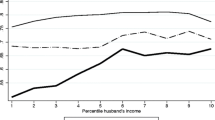Abstract
This paper contains a theoretical and empirical analysis of the labor supply of married women in the Federal Republic of Germany. The theoretical model is an intrafamily life cycle model. The empirical part uses individual census data of married women. The estimates are corrected for the selectivity bias using a two-stage probit method. Both dimensions of labor supply—hours and participation—are estimated along with an implicit estimation of the reservation wage function. The magnitude of the influence of economic variables and individual characteristics is evaluated and compared with other studies.
Similar content being viewed by others
References
Ashenfelter, O., andJ. J. Heckman: The Estimation of Income and Substitution Effects in a Model of Family Labor Supply. Econometrica42, 1974, 73–85.
Barten, A.P.: Evidence on the Slutzky Conditions for Demand Equations. Review of Economics and Statistics49, 1976, 77–84.
Franz, W.: Ein makroökonometrisches Vierteljahresmodell des Arbeitsmarktes der Bundesrepublik Deutschland 1960–1971. Mannheim 1974.
Franz, W.: Economic Aspects of Female Labor Force Participation in the Federal Republic of Germany. Institut für Volkswirtschaftslehre und Statistik der Universität Mannheim, Discussion Paper No. 143-80, 1980.
Griliches, Z., B.H. Hall andJ.A. Hausman: Missing data and selfselection in large panels. Annales de l'Insee30/31, 1978, 137–176.
Gronau, R.: Wage Comparison—A Selectivity Bias. Journal of Political Economy82 1974, 1119–1145.
Hall, R.E.: Labor Supply and Aggregate Fluctuations. National Bureau of Economic Research, Working Paper No. 385, Cambridge, Mass., 1979.
Heckman, J.J.: Shadow Prices, Market Wages, and Labor Supply. Econometrica42, 1974, 679–694.
—: The Common Structure of Statistical Models of Truncation, Sample Selection and Limited Dependent Variables and a Simple Estimator for such Models. The Annals of Economic and Social Measurement5, 1976, 475–492.
Heckman, J.J.: Sample Selection Bias as a Specification Error with an Application to the Estimation of Labor Supply Functions. Female Labor Supply: Theory and Estimation. Ed. by J.P. Smith. Princeton 1980, 206–248.
Heckman, J.J., andT. MaCurdy: A Dynamic Model of Female Labor Supply. mimeo, 1979.
Heckman, J.J., andR.J. Willis: A Beta-logistic Model for the Analysis of Sequential Labor Force Participation by Married Women. Journal of Political Economy85, 1977, 27–58.
Kosters, M.: Income and Substitution Effects in a Family Labor Supply Model. The Rand Corporation, P-3339. Santa Monica 1966.
Lee, L., G.S. Maddala andR.P. Trost: Asymptotic Covariance Matrices of Two-Stage Probit and Two-Stage Tobit Methods for Simultaneous Equations Models with Selectivity. Econometrica48, 1980, 491–503.
MaCurdy, T.E.: An Empirical Model of Labor Supply in a Life Cycle Setting. National Bureau of Economic Research, Working Paper No. 421, Cambridge, Mass., 1980.
Mincer, J.: Labor Force Participation of Married Women. Aspects of Labor Economics. Ed. by H.G. Lewis. National Bureau of Economic Research. Princeton 1962, 63–105.
—: Schooling, Experience and Earnings. National Bureau of Economic Research, New York 1974.
Nakamura, M., A. Nakamura andD. Cullen: Job Opportunities, the Offered Wage, and the Labor Supply of Married Women. The American Economic Review69, 1979, 787–805.
Rosenbaum, S.: Moments of a Truncated Bivariate Normal Distribution. Journal of the Royal Statistical Society23 (2), 1961, 405–409.
Smith, J.P.: Female Labor Supply: Theory and Estimation. Princeton 1980.
Author information
Authors and Affiliations
Additional information
This paper is a part of the research on labor economics within the Sonderforschungsbereich 5 at the University of Mannheim.
Rights and permissions
About this article
Cite this article
Franz, W., Kawasaki, S. Labor supply of married women in the Federal Republic of Germany: Theory and empirical results from a new estimation procedure. Empirical Economics 6, 129–143 (1981). https://doi.org/10.1007/BF02509786
Received:
Revised:
Issue Date:
DOI: https://doi.org/10.1007/BF02509786




